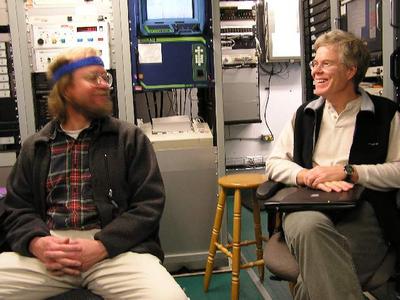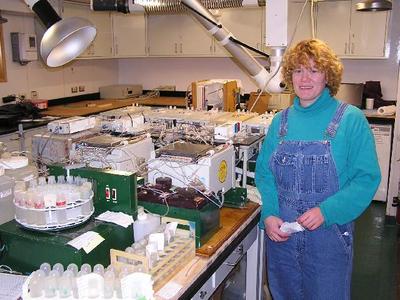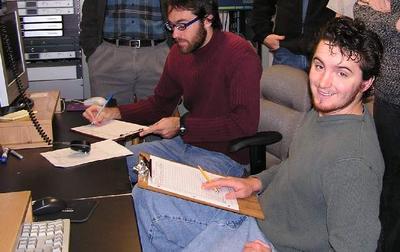
|
|
19 August, 2003
I departed the R/V Nathaniel B. Palmer today; therefore, I'm writing this last entry from home. A short helicopter flight early in the morning dropped me in Barrow where I managed to get onto the Alaska Airline flight to Fairbanks and Anchorage, then a connection to Seattle, finally arriving in Kalispell, Montana about midnight. Although everyone had been conveying their farewells for the past two days, a small contingent of well-wishers were present to see me off nonetheless. An always smiling Jim Swift and Rob Palomares were the first to greet me, Karl Newyear surprised me with some Palmer souvenirs, and Marie Beaupre and Leopoldo Llinas were ready with big hugs. Although his job made it necessary, the last person to say "so long mate" was Bruce Andrews, the helicopter pilot; but, I suspect he would have been there anyway as he may be the world's most friendly person.
Among those gathered in the Palmer's helicopter hangar that morning were several of the scientists and technicians from the Scripps Institute of Oceanography. This is the group that represents the core of the science team for they are true oceanographic professionals. Along with graduate students Craig Aumack and Jermey Mathias, I worked most closely with these pros from Scripps, and I must say they are the folks that I'll miss the most; indeed, it is easy to think of many as family. If you have visited this website on a regular basis, you may have noticed them scattered throughout the daily journal entries, but herewith in one place is Team Scripps:
1. Dr. Jim Swift, the Chief Scientist for this cruise, is an oceanographer who is interested in ocean measurement and interpretation that specializes in the physical characteristics of the Arctic Ocean. This is his 23rd scientific cruise which means that he has spent over two and a half years at sea collecting and analyzing oceanographic data. Jim is responsible for all of the science that is taking place on the Palmer; and therefore, he has his hand in literally everything. One of my early impressions recalls Jim drawing 24 dissolved oxygen samples from the water bottles on the rosette with his bare hands exposed to the below freezing temperatures (29 degrees F.) of arctic seawater. I could only do a few samples before the pain from the cold water forced me to wear gloves. But that is Jim's approach to all the work- he simply jumps right in and helps with whatever needs to be done. And even though he has a million things to do, Jim was always the first to reach the water bottles and begin sampling after each CTD cast- as if he just couldn't wait to see what the ocean might reveal next. Jim's overall enthusiasm and eagerness for learning makes him a pleasure to work with and underscores how fun it is to do science;
2. Kristin Sanborn and Marie Beaupre serve as the data processors for the cruise, and as a result, they spend a large part of their time working with computers. Marie and Kristin calculate final values of the seawater's oxygen and salt content as well as several nutrients on a daily basis which they pass on to Jim Swift for analysis. They also check for data irregularities and sometimes spend a fair amount of their time working with the other scientists and technicians in troubleshooting the problems that inevitably arise. Both of these highly experienced technicians have parcticipated in so many voyages over the years that, according to Marie, "it all seems like one long cruise." And they both have other duties too. Marie helps with processing dissolved oxygen samples in the ship's Hydro Lab and "baby sits" the nutrient analyzer when the chemist needs a break. Kristin supervises the night watch and directs the action in the Baltic Room during every CTD cast as the sample cop (which is my job on the day shift);
3. Rob Palomares and John Calderwood are electronics technicians. Any problems that need to be taken care of whether it is with the CTD equipment (including a variety of sensors and probes), the rosette's water bottles, or the computers and their linkages, these guys fix it, or at least, make it work one way or the other. As Rob puts it, "we're responsible for the care and feeding of all the equipment." But they do far more as well. Both will process dissolved oxygen samples and run yet others through the salinometer to analyze the salt in the water. And each time the rosette water sampler comes up on deck, they are ready to help with drawing the samples from the Niskin bottles. As an "old salt," that began going to sea in the Navy while working on nuclear submarines, Rob has a wealth of experience that he readily shares like a mentor to the graduate students that are learning the inner workings of all the scientific gear that they will build their careers on during future cruises. Although not as experienced as his colleague, you can find John doing much the same as the "go to guy" when something is amiss during the night shift; and,
4. Susan Becker and Paul Ellis are, respectively, the chemistry specialist and chemistry assistant for the cruise. A six-channel suite of nutrient values was required from every cast of the rosette which means Susan analyzed over 3500 samples in the ship's Hydro Lab. This sensitive and all-too-delicate piece of machinery that manages to operate smoothly on a rocking ship- largely because of Susan's highly developed skills and experience- determines the amount of nitrate, nitrite, silicate, phosphate, ammonia, and urea in each sample of seawater. Chief Scientist Jim Swift, in fact, says that "Susan is one of the best nutrient analysts in the business." Her talent for problem solving is sometimes put to the test when the analyzer "acts up." "It's easy to recognize a problem, but tracking it down is the challenge" Susan observes while she patiently checks some tubing connections with the pump. And helping her out in the lab is Paul Ellis who does many other things too. During the night shift, you can find him in the Baltic Room drawing dissolved oxygen samples from the water bottles and/or processing those same samples in the Hydro Lab. Although Paul is the youngest and least experienced of the Scripps team, I see a bright and successful future for this enthusiastic and always cheerful technician who never fails to make whatever we are doing fun.
That is a trait shared by everyone on the Scripps team from the Chief Scientist to the least experienced technician: They bring a sense of humor to everything they do. It goes without saying that these well-trained scientists and technicians are among the best there is, but when you're out at sea for 46 days and your responsibilities confine you to a few small labs on the ship, the ability to find fun in your work and get along well with your colleagues is essential. A broken cable, a glitch in an instrument, a chemical reagent gone bad, a faulty ammonia channel, an oxygen probe that has "sucked-in" a jellyfish, or irregular data can make for a frustrating day, but keeping a positive attitude to the setbacks that will inevitably occur is a talent shared only by people who really enjoy their jobs. And Team Scripps is second to none in that department.

1. Chief Scientist Dr. Jim Swift (on the right) with Dr. Eric Johnson.

2. Data processors Marie Beaupre (left) and Kristin Sanborn.

3. Electronics technicians John Calderwood and Rob Palomares drawing water samples.

4. Susan Becker with the nutrient analyzer in the Hydro Lab.

5. Paul Ellis charting a deep cast in the Forward Dry Lab with graduate student Leopold Llinas in the background.
Contact the TEA in the field at
.
If you cannot connect through your browser, copy the
TEA's e-mail address in the "To:" line of
your favorite e-mail package.
|
